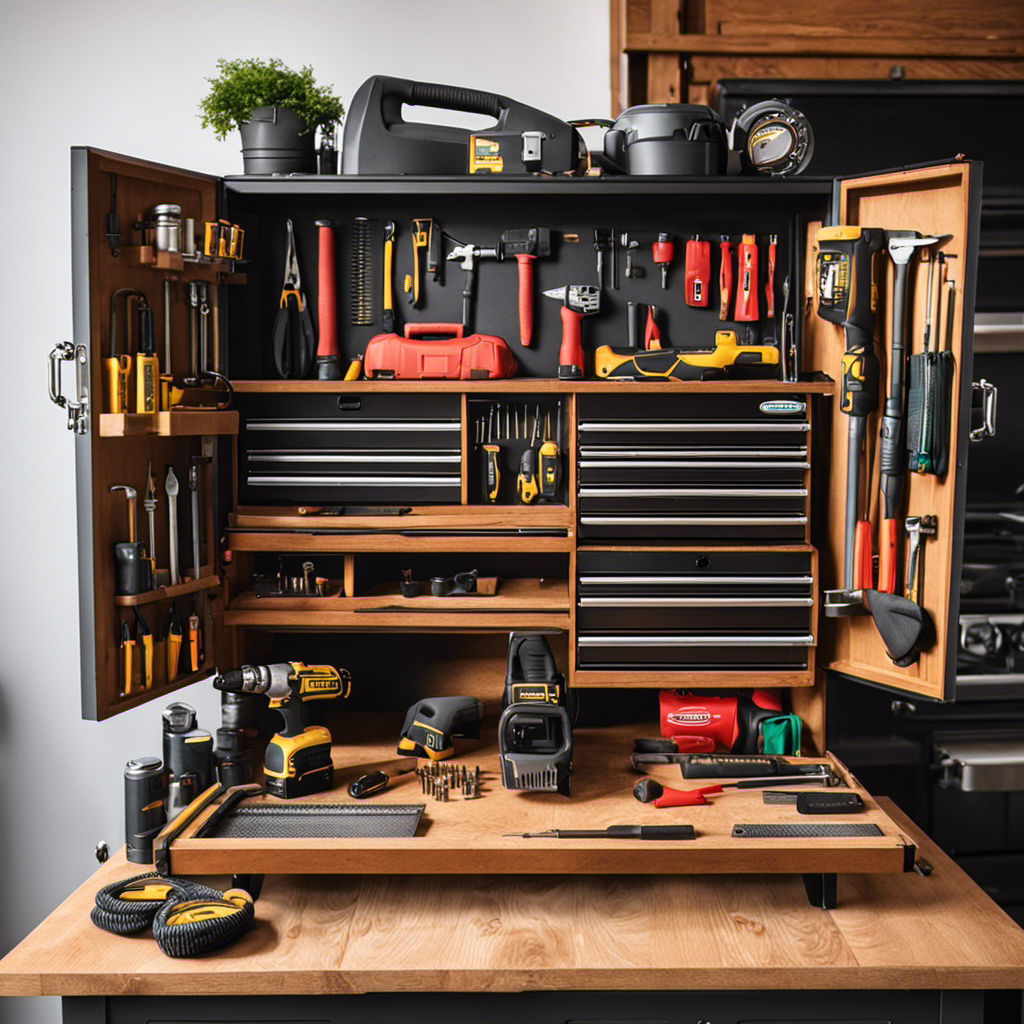When it comes to preparing for a wood stove installation, we’ve got you covered. From essential tools and required materials to safety equipment and venting systems, we’ll guide you through every step.
With our expert advice, you’ll learn how to choose the right insulation and fireproofing materials, as well as the tools for cutting and measuring.
We’ll also show you how to securely mount your wood stove and add those finishing touches for a polished look.
Let’s get started!
Key Takeaways
- Fireproof gloves, chimney brush, ash shovel, and creosote remover are essential tools for maintaining and cleaning the wood stove.
- Proper venting requirements and safety precautions must be followed to ensure the safe operation of the wood stove.
- Choosing the right venting system, such as double-wall stainless steel chimney pipe, is important for efficient heat transfer and durability.
- Insulation, cutting tools, and securely mounting the wood stove are crucial steps in the installation process to protect property and individuals.
Essential Tools for Wood Stove Installation
We’ll need a few essential tools for the wood stove installation. Proper tools are crucial to ensure a successful installation and to maintain the wood stove in the long run. Here are some tools that you should have on hand:
-
Fireproof Gloves: When handling the stove and working with hot parts, fireproof gloves are essential for protection against burns.
-
Chimney Brush: Regular cleaning of the chimney is vital for maintaining the efficiency of your wood stove. A chimney brush will help remove creosote buildup and prevent chimney fires.
-
Ash Shovel: Cleaning out the ashes from the stove is a necessary task. An ash shovel makes this chore easier and safer.
-
Stove Pipe Thermometer: Monitoring the temperature of the stove pipe is crucial for safety and efficiency. A stove pipe thermometer will help you regulate the heat output and prevent over-firing.
-
Creosote Remover: As part of regular maintenance, it’s important to remove creosote buildup from the chimney and stove pipes. A good quality creosote remover will help extend the lifespan of your wood stove.
Required Materials for a Successful Installation
In order to ensure a successful installation, we’ll need to gather a few key materials. These include essential installation supplies such as stove pipe, chimney connectors, and fireproof insulation.
Additionally, it’s crucial to adhere to proper venting requirements to prevent any potential hazards.
Lastly, we must prioritize safety precautions throughout the installation process to protect both ourselves and the property.
Essential Installation Supplies
Our first step is gathering all the necessary supplies for the wood stove installation. Having the right installation supplies is crucial for a smooth and successful installation process.
We’ll need a few key items to ensure the stove is installed correctly and safely. First and foremost, we need a chimney liner kit, which includes the necessary components to properly vent the stove. Additionally, we’ll need a chimney cap to prevent debris and animals from entering the chimney.
Other important supplies include fireproof insulation, stovepipe connectors, and high-temperature sealant. It’s also essential to have a fireproof hearth pad to protect the floor and surrounding area. Lastly, we should have a fire extinguisher nearby for added safety.
Proper Venting Requirements
To properly vent the wood stove, it is crucial that we adhere to the proper venting requirements. Venting options for wood stoves include through-the-wall venting, through-the-ceiling venting, and chimney venting. Each option has its own advantages and considerations.
Through-the-wall venting is a popular choice as it allows for easy installation and provides efficient heat distribution. Through-the-ceiling venting is another option, but it requires careful planning to ensure proper clearance and insulation. Chimney venting is the most traditional method and offers a classic look, but it requires regular maintenance and cleaning.
Here is a table summarizing the venting options and their considerations:
| Venting Option | Advantages | Considerations |
|---|---|---|
| Through-the-wall | Easy installation | Heat distribution may be uneven |
| Through-the-ceiling | Efficient heat distribution | Clearance and insulation planning required |
| Chimney | Classic look | Regular maintenance and cleaning required |
When installing the venting system, there are a few important tips to keep in mind. First, it is crucial to follow the manufacturer’s instructions and local building codes. Additionally, proper clearances must be maintained to ensure the safe operation of the wood stove. Finally, it is recommended to consult with a professional if you are unsure about any aspect of the venting installation process.
Now that we understand the proper venting requirements, let’s move on to the next section, where we will discuss the safety precautions for installation.
Safety Precautions for Installation
As we proceed to the safety precautions for installation, it’s important to consider all necessary measures for a secure and successful process.
When installing a carbon monoxide detector, it’s crucial to place it in a central location, at least five feet from the ground. This will ensure early detection and protect against the dangers of carbon monoxide poisoning.
Additionally, it’s essential to have a fire extinguisher readily accessible in the event of a fire. The fire extinguisher should be placed near the wood stove, within easy reach, and make sure it’s regularly checked and maintained. Proper fire extinguisher placement is vital to effectively extinguish any potential fire and prevent it from spreading.
Safety Equipment and Precautions
We should always wear the proper safety equipment before starting any wood stove installation. Safety gear is essential to protect ourselves from potential hazards that can arise during the installation process. When working with wood stoves, there are several installation hazards that we need to be aware of.
One of the primary installation hazards is the risk of burns or injuries from hot surfaces. To prevent this, we should wear heat-resistant gloves and clothing. These safety measures will protect our skin from direct contact with hot components, reducing the risk of burns.
Another potential hazard is the release of harmful gases, such as carbon monoxide, during the installation process. To mitigate this risk, we should wear a respirator or mask specifically designed for filtering airborne particles and gases. This will help ensure that we aren’t exposed to any harmful substances while working.
Additionally, we should use safety goggles or glasses to protect our eyes from wood chips, sparks, or other debris that may be generated during the installation. These goggles should have impact-resistant lenses to provide adequate protection.
Choosing the Right Venting System
When choosing the right venting system for your wood stove, it’s essential to consider various factors. These include:
- The type of wood stove you have
- The layout of your home
- Local building codes and regulations
Venting System Options
Our top choice for the venting system is the double-wall stainless steel chimney pipe. This type of pipe is highly durable and resistant to corrosion, making it an ideal option for venting systems.
Here are three reasons why the double-wall stainless steel chimney pipe is a great choice for your wood stove installation:
-
Superior insulation: The double-wall design of this chimney pipe provides excellent insulation, ensuring that the heat is efficiently transferred out of your home. This helps to maximize the heating efficiency of your wood stove.
-
Easy installation: The double-wall stainless steel chimney pipe is designed for easy installation, making it a convenient option for homeowners. It’s lightweight and can be easily assembled, reducing the time and effort required for installation.
-
Low maintenance: With proper maintenance, the double-wall stainless steel chimney pipe requires minimal upkeep. Regular cleaning and inspection can help prevent issues such as creosote buildup, ensuring safe and efficient operation.
Proper Vent Installation
During the proper vent installation process, it is important to ensure that the double-wall stainless steel chimney pipe is securely connected and sealed to prevent any leaks or drafts. This is crucial for maintaining the efficiency and safety of your wood stove. A well-designed venting system is essential for proper operation and maintaining indoor air quality. Regular venting system maintenance is also vital to ensure the longevity and optimal performance of your wood stove. This includes inspecting the chimney pipe for any signs of damage or corrosion, cleaning the chimney regularly to remove creosote buildup, and checking the seals and connections for any potential leaks. By following these steps, you can ensure that your venting system is functioning effectively and safely, providing you with the warmth and comfort you desire.
| Venting System Design | Venting System Maintenance |
|---|---|
| Proper sizing and installation of the chimney pipe | Regular inspection for damage or corrosion |
| Correct placement and orientation of the chimney | Cleaning the chimney to remove creosote buildup |
| Adequate clearance from combustible materials | Checking seals and connections for leaks |
| Proper use of support brackets and connectors | Ensuring proper airflow and draft efficiency |
Insulation and Fireproofing Materials
We need to ensure that our insulation and fireproofing materials are properly installed for the wood stove installation. Proper insulation and fireproofing techniques are crucial in creating a safe and efficient environment for your wood stove.
Here are three important considerations when it comes to insulation and fireproofing materials:
-
Fire-resistant insulation: Choosing the right insulating materials is essential for preventing heat transfer and protecting your walls and floors from potential fire hazards. Opt for fire-resistant insulation materials such as mineral wool, fiberglass, or foam boards. These materials have high melting points and can withstand extreme temperatures.
-
Fireproof barriers: Installing fireproof barriers around your wood stove is vital to prevent the spread of flames. Use non-combustible materials like cement board or fire-rated drywall to create a protective barrier between the stove and surrounding walls or floors. This will help contain any potential fire incidents and minimize damage.
-
Sealant and caulk: To ensure proper insulation, it’s important to seal any gaps or openings in walls or floors where the stove pipe passes through. Use fire-resistant sealant or caulk specifically designed for high-temperature applications. This will prevent heat escape and minimize the risk of fire hazards.
By following these fireproofing techniques and using appropriate insulating materials, you can create a safe and well-insulated environment for your wood stove installation.
Now, let’s move on to the next section where we’ll discuss the essential tools needed for cutting and measuring during the installation process.
Tools for Cutting and Measuring
When it comes to cutting and measuring, accuracy is crucial for a successful installation. As professionals in the wood stove installation industry, we understand the importance of using the right cutting tools and measuring tools to ensure precise and efficient work.
For cutting, there are a few essential tools that every installer should have in their arsenal. A high-quality circular saw or jigsaw is a must-have for cutting through various materials such as plywood, fiberboard, or metal sheets. These tools provide clean and precise cuts, allowing for seamless installation of the wood stove.
Measuring tools play an equally important role in achieving accurate results. A reliable tape measure is a staple in any installer’s toolkit. It allows us to measure the dimensions of the installation area, ensuring the stove fits perfectly within the designated space. Additionally, a combination square helps in marking straight lines and right angles, ensuring precise cuts and alignments.
When using cutting tools and measuring tools, it’s crucial to prioritize safety. Wearing protective gear such as safety goggles and gloves is essential to prevent any potential accidents or injuries. Regularly maintaining and sharpening cutting tools also contributes to accuracy and safety during the installation process.
Securing and Mounting the Wood Stove
To ensure a secure and stable installation, our team carefully anchors and mounts the wood stove using heavy-duty brackets and secure fasteners. This is essential to prevent any accidents or damage caused by an improperly installed stove.
Here’s how we go about securing and mounting the wood stove:
-
Choosing the right mounting brackets: We select sturdy, high-quality mounting brackets that are specifically designed for wood stoves. These brackets are made from durable materials that can withstand the weight and heat of the stove.
-
Properly positioning the stove: Before securing the stove, we ensure that it’s placed in the correct position. This includes positioning it at a safe distance from combustible materials and allowing for proper ventilation.
-
Floor protection: To protect the floor from heat and potential damage, we install a non-combustible floor pad or hearth. This can be made of materials such as tile, stone, or metal, and provides a barrier between the stove and the floor.
Finishing Touches and Accessories for a Polished Look
Now that we’ve successfully secured and mounted our wood stove, it’s time to focus on the finishing touches and accessories that will give our installation a polished look. Wood stove accessories not only enhance the overall aesthetic appeal of your wood stove but also add functionality and convenience.
One of the essential wood stove accessories is the heat shield. A heat shield is designed to protect combustible materials from the intense heat generated by the wood stove. It can be made from materials like ceramic tile or sheet metal and is installed on the wall or floor behind the stove.
Another popular accessory is the stove pipe thermometer. This handy device helps you monitor the temperature inside the stove, ensuring optimal burning efficiency and preventing over-firing. It also helps prevent creosote buildup in the chimney, reducing the risk of chimney fires.
To add decorative finishing touches to your wood stove installation, consider adding a hearth pad. A hearth pad not only provides a safe and heat-resistant surface but also adds a decorative element to your space. They come in various materials like stone, tile, or metal, allowing you to choose one that complements your home’s style.
In addition to these accessories, you can also consider installing a wood storage rack or a toolset near your wood stove for added convenience and organization.
Frequently Asked Questions
How Long Does It Typically Take to Install a Wood Stove?
Installing a wood stove typically takes a few hours to a full day, depending on various factors. Factors such as the size of the stove, the complexity of the installation, and any common challenges that may arise during the process can affect the overall time.
It’s important to choose the right size wood stove for your space to ensure optimal heating efficiency. Common challenges during wood stove installation include proper venting and ensuring compliance with local building codes.
Are There Any Specific Building Codes or Regulations That Need to Be Followed When Installing a Wood Stove?
When installing a wood stove, it’s important to be aware of the building code requirements and safety regulations that need to be followed. These regulations are in place to ensure that the installation is done correctly and safely.
Building codes may vary depending on your location, so it’s crucial to research and understand the specific requirements for your area. This will help ensure that your wood stove installation is compliant with all necessary regulations and standards.
Can a Wood Stove Be Installed in Any Type of Home or Does It Require a Specific Type of Construction?
Installing a wood stove can be a daunting task, especially when dealing with unique home constructions. Wood stove installation in historic homes can pose challenges due to the age and design of the structure.
Mobile homes, on the other hand, require special considerations to ensure proper ventilation and safety.
It’s crucial to consult with professionals who’ve experience in these specific types of installations.
Taking these factors into account will help ensure a successful wood stove installation in any type of home.
How Often Does a Wood Stove Need to Be Cleaned and Maintained?
When it comes to the frequency of cleaning and maintenance for wood stoves, it’s important to stay on top of it to ensure optimal performance and safety.
Regular cleaning of the stovepipe, chimney, and flue is recommended, usually once a year or more depending on usage.
Additionally, proper maintenance involves inspecting and replacing gaskets, checking for any cracks or damage, and ensuring proper ventilation.
Following these tips will help keep your wood stove in top condition and prolong its lifespan.
Can a Wood Stove Be Installed in a Multi-Story Home, or Is It Only Suitable for Single-Level Homes?
Installing a wood stove in a multi-story home is indeed possible, as long as proper precautions are taken. It requires careful planning and professional expertise to ensure the stove is safely installed and vented.
Regular maintenance is crucial for any wood stove, regardless of its location. This includes cleaning the chimney and flue, inspecting the stove for any wear or damage, and ensuring proper airflow.
Conclusion
In conclusion, by having the essential tools, required materials, and safety equipment, you can successfully install a wood stove.
The right venting system, insulation, and fireproofing materials will ensure a safe and efficient operation.
With precise cutting and measuring tools, you can secure and mount the wood stove securely.
Finally, adding finishing touches and accessories will give your installation a polished and visually appealing look.
Remember to follow all safety precautions and consult a professional if needed for a successful wood stove installation.





